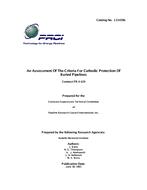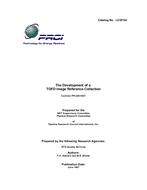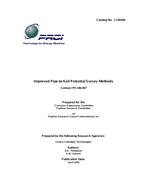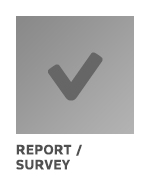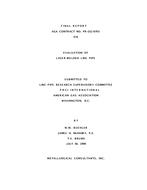Provide PDF Format
PRCI PR-3-129
- An Assessment of the Criteria for Cathodic Protection of Buried Pipelines
- Report / Survey by Pipeline Research Council International, 06/30/1983
- Publisher: PRCI
$98.00$195.00
L51439e
Battelle Memorial Institute
Need: Research project PR-3-129 was initiated as a result of the findings of earlier research on PR-3-93, "Investigation of Techniques to Determine the True Pipe-to-Soil Potential of a Buried Pipeline: Supplementary Studies". The research on project PR-3-93, conducted in 1980, showed that the present criteria for corrosion control by cathodic protection (1) evolved largely from experience, (2) can be overly conservative in some cases, (3) can be inadequate in others, and (4) are not necessarily consistent among themselves. As a result of these findings, research was undertaken on PR-3-129 to critically assess the present criteria for cathodic protection in the laboratory. The research began in September 1980, and was completed in December 1982. The overall objective of the research was to develop a method for determining the requirements to mitigate general and pitting corrosion on any individual pipeline. The method was expected to be safe, not overly conservative, and capable of being tailored to specific environmental conditions.
Result: To meet this objective, research was undertaken to (1) determine the specific cathodic protection requirements to prevent general and pitting corrosion from starting in various soil environments, (2) determine the effects of temperature, anaerobic bacteria, steel-surface condition, and time on the specific requirements in selected soils, (3) develop a better understanding of those factors that control the criteria for corrosion control, and (4) determine the requirements to stop active corrosion pit growth. On some pipelines, stress-corrosion cracking may occur at potentials where corrosion is prevented; therefore, the research was directed also to (1) determine the least negative potential to prevent stress-corrosion cracking, and (2) determine the most negative potential for preventing stress-corrosion cracking.
Benefit: Progress has been made in improving the understanding of the factors that control corrosion and, hence, the criteria, as a result of this research. This was the first research to quantitatively identify corrosion-control criteria when stress-corrosion cracking is a consideration.
Battelle Memorial Institute
Need: Research project PR-3-129 was initiated as a result of the findings of earlier research on PR-3-93, "Investigation of Techniques to Determine the True Pipe-to-Soil Potential of a Buried Pipeline: Supplementary Studies". The research on project PR-3-93, conducted in 1980, showed that the present criteria for corrosion control by cathodic protection (1) evolved largely from experience, (2) can be overly conservative in some cases, (3) can be inadequate in others, and (4) are not necessarily consistent among themselves. As a result of these findings, research was undertaken on PR-3-129 to critically assess the present criteria for cathodic protection in the laboratory. The research began in September 1980, and was completed in December 1982. The overall objective of the research was to develop a method for determining the requirements to mitigate general and pitting corrosion on any individual pipeline. The method was expected to be safe, not overly conservative, and capable of being tailored to specific environmental conditions.
Result: To meet this objective, research was undertaken to (1) determine the specific cathodic protection requirements to prevent general and pitting corrosion from starting in various soil environments, (2) determine the effects of temperature, anaerobic bacteria, steel-surface condition, and time on the specific requirements in selected soils, (3) develop a better understanding of those factors that control the criteria for corrosion control, and (4) determine the requirements to stop active corrosion pit growth. On some pipelines, stress-corrosion cracking may occur at potentials where corrosion is prevented; therefore, the research was directed also to (1) determine the least negative potential to prevent stress-corrosion cracking, and (2) determine the most negative potential for preventing stress-corrosion cracking.
Benefit: Progress has been made in improving the understanding of the factors that control corrosion and, hence, the criteria, as a result of this research. This was the first research to quantitatively identify corrosion-control criteria when stress-corrosion cracking is a consideration.
Related Products
PRCI L51660
Development of Simplified Weld Cooling Rate Models for In-Service Gas Pipelines..
$713.00 $1,425.00

